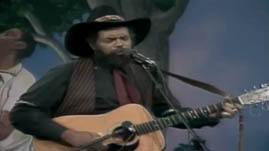Teachers' Domain - Digital Media for the Classroom and Professional Development
User: Preview



“Gospel Train” is a code-word song used in the Underground Railroad by slaves, often sung just before an escape in an attempt to let all who wished to go know that the time was near. In this segment, folk singers Rhonda and Sparky Rucker perform the piece on harmonica and guitar. This segment also includes a discussion of the harmonica, an instrument that has played an essential role in the American blues and folk tradition. Rhonda Rucker demonstrates how to play different harmonies on the harmonica.
This resource is part of the Civil War Era collection. Find additional arts resources for your classroom at the KET Arts Toolkit website.
Gospel Train
“Gospel Train” is an African-American spiritual, also thought to be a code song used in the Underground Railroad that helped slaves escape to freedom in antebellum America. The abolitionist-inspired movement had many code-word songs, such as “Swing Low, Sweet Chariot,” “Steal Away,” “The Tar River’s Gonna Run Tomorrow,” and “I’m on My Way to Canaan (Canada) Land.” These code songs were used to spread information about impending escape attempts to slaves, but to slave owners, they sounded simply like religious songs.
“Gospel Train” is full of symbols and railroad terminology. The title refers to the Underground Railroad, which was organized like a railroad with “stations” for the runaways to stop and hide. These places were usually in the homes of sympathizers, perhaps a Quaker family. The runaways could hide in a false cellar, the barn, a cave, or any unlikely place. There were also “conductors,” usually previously escaped slaves who knew the particular route the escapees would be taking. The reference to “heaven” in the last verse literally meant “freedom” to the original singers of this song.
Code songs are one example of the myths and mystiques that surround the Underground Railroad. While there is documentation for the idea that slaves used code songs to communicate to each other, some Underground Railroad stories may be more legend than fact, or, at the very least, controversial. An example is the use of quilts to convey coded messages. The book Hidden in Plain View: A Secret Story of Quilts and the Underground Railroad suggests that slaves made and used quilts to send coded messages about how to escape on the Underground Railroad. However, historians and quilt experts dispute this idea because it was based on the oral history of one woman, and scholars have not been able to find other sources or evidence that quilts were used in this way.
 Loading Standards
Loading Standards